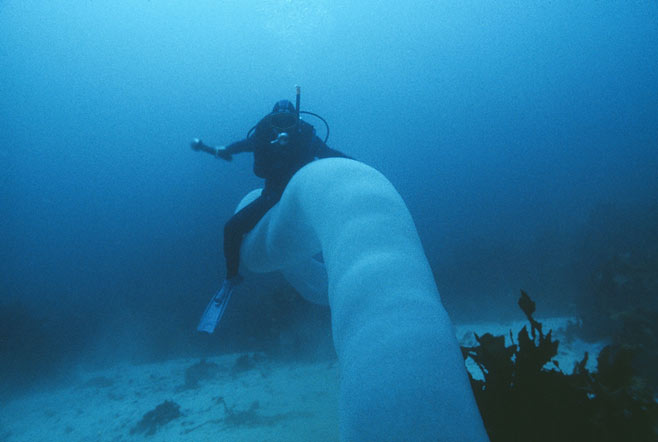Pyrostremma spinosum (Giant fire salp)
[= Pyrosoma spinosum]
Life > Eukaryotes > Opisthokonta > Metazoa
(animals) >
Bilateria > Deuterostomia >
Chordata > Tunicata >
Thaliacea > Pyrosomatida > Family: Pyrosomatidae
> Genus: Pyrostremma
 |
|
A massive, tubular colony of Pyrostremma
spinosum photographed off Montague Island in NSW, Australia, close to the
continental shelf in 25 meters of water, in 1985. [Photo by Mr Roger
Fenwick ©, Victoria, Australia] |
Description
Forms tubular colonies that can exceed 20 m in
length! The open side of the tube is the posterior end (the common
cloaca) and in a 10.2 m long colony, was measured at 1.2. m in
diameter. It often has a very long tail projecting from the rim of
the opening that can be as long as the colony. The colony tapers to
the anterior end, which is closed and pointed. The wall of the
tube is made up of individual animals (zooids) that are embedded in
a gelatinous test. The external surface of the test is covered with
blunt, spine-like pyramids of fairly rigid jelly, with one pyramid
next to the oral siphon of each zooid. These projections are about 5
mm apart and 2-3 mm high (Baker 1971). The oral (inhalent) siphon of
each zooid is on the outside of the colony and the atrial (exhalent)
siphon on the inside of the tube. The combined filtering of water
from the outside to the inside of the tube by these thousands of
zooids helps to keep the tube cylindrical in shape. It actually is
quite fragile and if it is taken out of the water it collapses.
Zooids are up to 14.3 mm long, with the oral
siphon 0.5 mm long and the cloacal siphon 5.2 mm long (van Soest
1981). Zooids of the other species in the genus, Pyrostremma
agassizi, are only 8 - 10 mm long. The greater length of
Pyrostremma spinosum zooids is mainly because of the long
cloaca.
Distribution and habitat
A pelagic species that occurs in all oceans from 40°N to 45°S (Van Soest 1981).
The distribution map in Van Soest (1981) shows one record from
southern African waters (well off the east coast). The records
of huge colonies of Pyrostremma spinosum are all from
Australia and New Zealand (Griffin & Yaldwyn 1970; Baker 1971). I
have found no records of similar sized individuals from southern
African waters and marine biologists and divers that I have spoken
to are unfamiliar with pyrosomatid colonies that reach these sizes
in this region. Evidently the usual size of Pyrostremma spinosum
colonies is about 20-50 cm long (Baker 1971) and so presumably it is
these sized colonies that are more the norm in southern African
waters.
As these colonies are very fragile, they can
get broken up by surface waves. Observations of the larger colonies
have been at depths below the level of strong wave action, to as
deep as 40 m (Baker 1971).
Publications (by date)
- Griffin DJG, Yaldwyn JC. 1970. Giant colonies of pelagic
tunicates (Pyrosoma spinosum) from SE Australia and New
Zealand. Nature 226: 464.
doi:10.1038/226464a0
- Baker AN. 1971. Pyrosoma spinosum Herdman, a giant
pelagic tunicate new to New Zealand waters. Records of the
Dominion Museum 7(12): 107-117.
- Van Soest RWM. 1981. A monograph of the order Pyrosomatida
(Tunicata, Thaliacea). Journal of Plankton Research 3(4):
603–631.
Text by Hamish Robertson |
